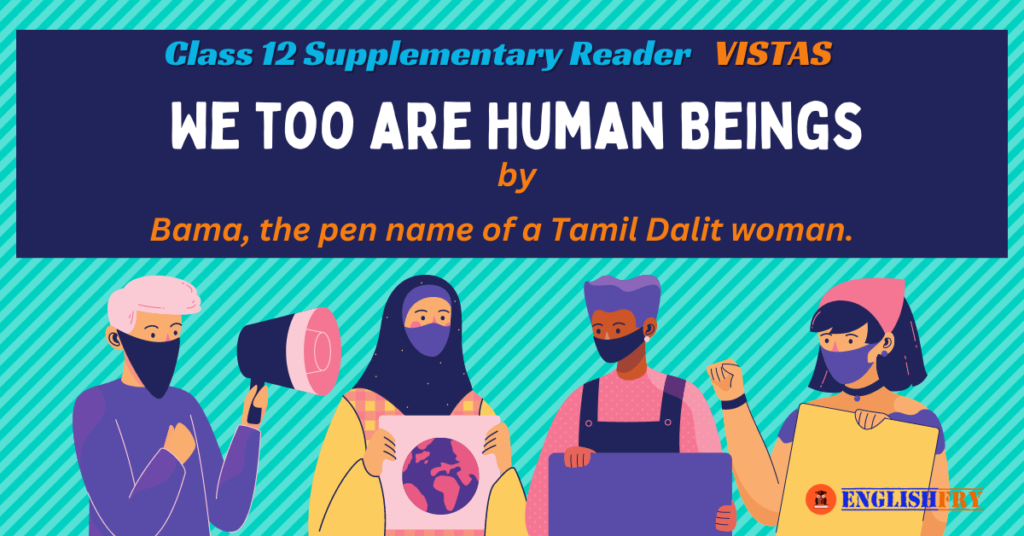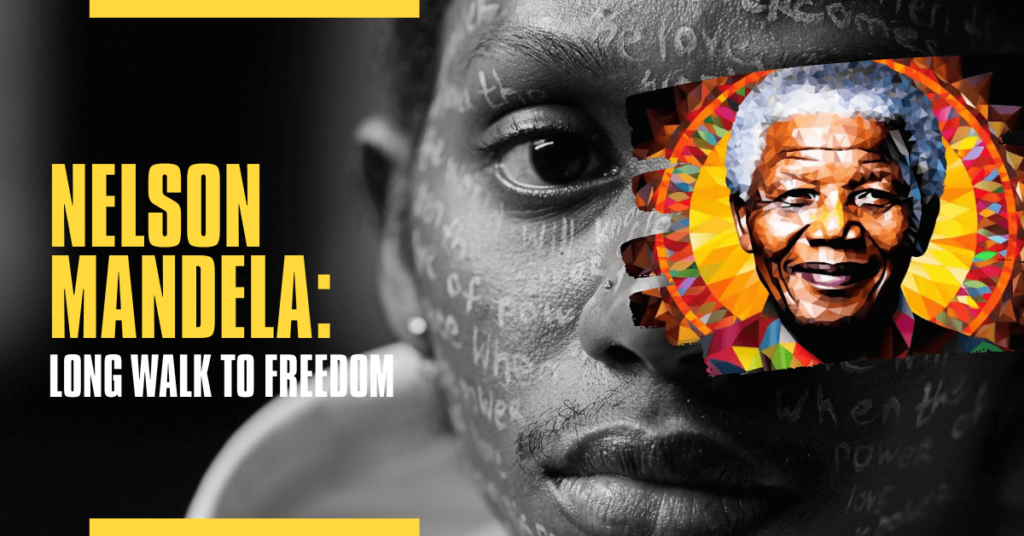Bama was a student of third class. She never heard of the word untouchability during her childhood. Certain small events of her life made her feel that she was born in the marginalized caste. She was a happy peppy girl and once when she was in the third class, while going home she saw her people working hard for their land- lords. In spite of their hard work the landlords treated the workers very humiliatingly. She saw from the direction of the market an elder from their community was coming with a parcel in his hands. The manner he carried the poly bag, the manner he was carrying it with its strings, without touching the Vadas inside the parcel, really made him to be funny. He handed over the parcel to the landlord very sacredly too. She narrated the incident to her brother, taking the incident as humorous and funny. He told that it was not humorous but
humiliating as the elderly person was not supposed to touch the item inside the parcel. On hearing that Bama felt infuriated.
She saw her people bowing, to the upper caste people. She was enraged why her elders work so hard for those people who despised them so much. She wanted her people to stop paying undue respect and reverences to these upper caste people. Her brother told her that if they study hard and make progress in their lives, it would help them in throwing away the indignities. Education is their weapon with which they fight back the society. Bama did the same and got many friends in her life. Education made her as double- sided sward to fight very sharply against the unjustified caste system.
Main Points
- Bama was a victim of caste system, she had seen, felt & experienced the evils of
- She struggled hard against this social
- She studied hard & topped in her class & many students became her

Table of Contents
ToggleWe too are Human Beings summary in Hindi
बामा तीसरी कक्षा की छात्रा थी। बचपन में उसने कभी छुआछूत शब्द नहीं सुना था। उसके जीवन की कुछ छोटी-छोटी घटनाओं ने उसे यह एहसास दिलाया कि वह हाशिए की जाति में पैदा हुई है। वह एक खुशमिजाज लड़की थी और एक बार जब वह तीसरी कक्षा में थी, तो घर जाते समय उसने अपने लोगों को अपने जमींदारों के लिए कड़ी मेहनत करते देखा। उनकी कड़ी मेहनत के बावजूद जमींदारों ने मजदूरों के साथ बहुत अपमानजनक व्यवहार किया। उसने देखा कि बाजार की दिशा से उनके समुदाय का एक बुजुर्ग हाथ में पार्सल लेकर आ रहा था। जिस तरह से वह पॉली बैग ले जा रहा था, जिस तरह से वह पार्सल के अंदर वड़ों को छुए बिना उसे डोरियों के साथ ले जा रहा था, वह वाकई बहुत मजाकिया लग रहा था। उसने भी बहुत पवित्रता से पार्सल जमींदार को सौंप दिया। उसने घटना को अपने भाई को बताया, जिसने इसे हास्यपूर्ण और मजाकिया माना। उसने बताया कि यह हास्यपूर्ण नहीं बल्कि अपमानजनक था क्योंकि बुजुर्ग व्यक्ति को पार्सल के अंदर की वस्तु को छूना नहीं चाहिए था। यह सुनकर बामा को गुस्सा आ गया। उसने देखा कि उसके लोग ऊंची जाति के लोगों के सामने झुक रहे थे। वह इस बात से क्रोधित थी कि उसके बड़े लोग उन लोगों के लिए इतनी मेहनत क्यों करते हैं जो उन्हें इतना तिरस्कृत करते हैं। वह चाहती थी कि उसके लोग इन उच्च जाति के लोगों को अनुचित सम्मान और श्रद्धा देना बंद कर दें। उसके भाई ने उससे कहा कि अगर वे कड़ी मेहनत से पढ़ाई करें और अपने जीवन में प्रगति करें, तो इससे उन्हें अपमान को दूर करने में मदद मिलेगी। शिक्षा उनका हथियार है जिसके साथ वे समाज से लड़ते हैं। बामा ने भी ऐसा ही किया और अपने जीवन में कई दोस्त बनाए। शिक्षा ने उन्हें अनुचित जाति व्यवस्था के खिलाफ बहुत तेजी से लड़ने के लिए दोतरफा तलवार बना दिया।
मुख्य बिंदु
1. बामा जाति व्यवस्था की शिकार थीं, उन्होंने छुआछूत की बुराइयों को देखा, महसूस किया और अनुभव किया था।
2. उन्होंने इस सामाजिक भेदभाव के खिलाफ कड़ा संघर्ष किया।
3. उन्होंने कड़ी मेहनत की और अपनी कक्षा में अव्वल रहीं और कई छात्र उनके दोस्त बन गए।

We too are Human Beings summary in Assamese
বামা আছিল তৃতীয় শ্ৰেণীৰ ছাত্ৰ। শৈশৱ কালত অস্পৃশ্য শব্দৰ কথা তাই কেতিয়াও শুনা নাছিল। জীৱনৰ কিছুমান সৰু সৰু ঘটনাই তাইক প্ৰান্তীয় জাতিত জন্ম লোৱা যেন অনুভৱ কৰাইছিল। তাই আছিল এগৰাকী সুখী পেপি ছোৱালী আৰু এবাৰ তাই তৃতীয় শ্ৰেণীত পঢ়ি থাকোঁতে ঘৰলৈ গৈ থাকোঁতে তাইৰ মানুহে নিজৰ ঘৰৰ মালিকৰ বাবে কঠোৰ পৰিশ্ৰম কৰা দেখিছিল। কঠোৰ পৰিশ্ৰমৰ পিছতো ঘৰৰ মালিকসকলে শ্ৰমিকসকলৰ লগত অতি অপমানজনক ব্যৱহাৰ কৰিছিল। তাই বজাৰৰ দিশৰ পৰা দেখিলে তেওঁলোকৰ সমাজৰ এজন বয়োজ্যেষ্ঠ হাতত এটা পাৰ্চেল লৈ আহি আছে। পলি বেগটো যি ধৰণেৰে কঢ়িয়াই লৈ ফুৰিছিল, তাৰ ডোঙাৰে কঢ়িয়াই লৈ ফুৰিছিল, পাৰ্চেলৰ ভিতৰৰ ভাদাবোৰক স্পৰ্শ নকৰাকৈয়ে, সঁচাকৈয়ে তেওঁক ধেমেলীয়া কৰি তুলিছিল। তেওঁও অতি পবিত্ৰভাৱে পাৰ্চেলটো ঘৰৰ মালিকৰ হাতত তুলি দিলে। ঘটনাটোক হাস্যৰসময়ী আৰু ধেমেলীয়া বুলি লৈ তাই ভায়েকৰ আগত ঘটনাটো বৰ্ণনা কৰিলে। তেওঁ ক’লে যে ই হাস্যৰসময়ী নহয় কিন্তু…
অপমানজনক কাৰণ বৃদ্ধজনে পাৰ্চেলৰ ভিতৰৰ বস্তুটো স্পৰ্শ কৰাৰ কথা নাছিল। সেই কথা শুনি বামাৰ খং উঠিল।
তাই দেখিলে তাইৰ মানুহবোৰে প্ৰণাম কৰা, উচ্চ বৰ্ণৰ মানুহবোৰৰ ওচৰত। তাইৰ ক্ষোভিত হৈ পৰিছিল যে তাইৰ বয়োজ্যেষ্ঠসকলে তেওঁলোকক ইমান হেয়জ্ঞান কৰা সেই মানুহবোৰৰ বাবে কিয় ইমান কষ্ট কৰে। তাই বিচাৰিছিল যে তাইৰ মানুহে এই উচ্চবৰ্ণৰ লোকসকলক অযথা সন্মান আৰু শ্ৰদ্ধা দিয়া বন্ধ কৰক। তাইৰ ভায়েকে তাইক ক’লে যে যদি তেওঁলোকে কঠোৰভাৱে পঢ়া-শুনা কৰে আৰু জীৱনত অগ্ৰগতি লাভ কৰে তেন্তে ই তেওঁলোকক অসন্মানবোৰ পেলোৱাত সহায় কৰিব। শিক্ষা তেওঁলোকৰ অস্ত্ৰ যাৰ দ্বাৰা তেওঁলোকে সমাজৰ বিৰুদ্ধে যুঁজ দিয়ে। বামাইও একেই কাম কৰি জীৱনত বহু বন্ধু পালে। শিক্ষাই তাইক অযুক্তিকৰ জাতি ব্যৱস্থাৰ বিৰুদ্ধে অতি তীব্ৰভাৱে যুঁজিবলৈ দুপক্ষীয় গোট হিচাপে কৰি তুলিছিল।
মূল বিন্দু
১/ বামা জাতি ব্যৱস্থাৰ বলি হৈছিল, তাই অস্পৃশ্যতাৰ বেয়াবোৰ দেখিছিল, অনুভৱ কৰিছিল আৰু অনুভৱ কৰিছিল।
২/ এই সামাজিক বৈষম্যৰ বিৰুদ্ধে তাই কঠোৰ সংগ্ৰাম কৰিছিল।
৩/ তাই কঠোৰ পৰিশ্ৰম কৰিছিল & তাইৰ ক্লাছত শীৰ্ষস্থান দখল কৰিছিল & বহু ছাত্ৰ-ছাত্ৰী তাইৰ বন্ধু হৈ পৰিছিল।

We too are Human Beings Question and Answers
Q1. Why was the narrator taking an hour or half to reach home instead of ten minute?
Ans. The narrator was taking an hour or half to reach home as she used to watch the roadside fun and games. The entertaining novelties like the performing monkey, snake charmer‘s display of snake, marathon cycling, dried fish stall by the statue of Gandhi, street play or puppet show used to pull her stand still on her way back home.
Q2. What was going on at the opposite corner when Bama came to her street one day?
Ans. A threshing floor had been set up there. Some people of Bama‘s community were hard work. They were driving cattle round and round in pairs. They were treading out the grain from the straw.
Q3. Why did Bama want to laugh on seeing an elder of her street?
Ans. The elder was carrying a small packet by its string. He was holding it out so as not to touch it. There seemed to be Vadais in the packet because it was stained with oil. Bama wanted to laugh because that way the packet could get undone and the Vadais could fall out.
Q4. How did Bama come to know about untouchability?
Ans. Bama saw an elder of her community carrying a packet of vadais by its string. The packet was for the landlord. For Bama, it was a funny sight. But her brother told her that they were not supposed to touch the upper caste people. Their touch could pollute them. It was only then that Bama knew of the social discrimination faced by their community.
Q5. How did Annan explain to Bama that there was nothing funny about the elder carrying the packet by its string?
Ans. Annan told Bama that the landlord and his people were believed to be of upper caste. The Dalits were not supposed to touch them. By their touch, the upper caste people thought they were polluted. That was why the elder had to carry the packet by its string.
Q6. What advice did Annan offer Bama?
Ans. Annan advised Bama to study hard with care and learn all she could. He said that only by studying and by making progress, could they throw away their indignities.
Q7. Why did Bama study so hard?
Ans. Bama‘s brother who was studying at a University told her because they were born in a low caste they are deprived of honour and dignities. He advised her to study and make progress to throw away the indignities. The words of her brother left a deep impression in her mind and she studied hard.
Q8. What was the scene that first amused Bama but then filled her with anger and revolt?
Ans. A threshing floor had been set up at a corner of the street. It was a street where the Dalits lived. Some men of the street were working hard to separate the grain from the straw. The landlord was sitting on a piece of sacking spread over a stone ledge. Bama saw an elder man of the street coming from the side of the bazaar. He was holding out a packet by its string. The packet was stained with oil. It had probably vadais in it. Bama thought it was funny to carry the packet in that manner, because the packet could get undone and the vadais could fall out. But Bama‘s elder brother explained to her that there was nothing comic about it. The landlord and his people were believed to be of upper caste. The Dalits were not supposed to touch them. It could pollute the upper caste people.
On hearing this, Bama was filled with anger and revolt. She said, ―We too are human beings. Our people should never do these humiliating things for them. We should work in their fields, take home our wages, and leave it at that.‖
Q9. What oppression and discrimination did Zitkala-Sa and Bama experience during their childhood? How did the respond to their respective situations?
Ans. Both Zitkala-Sa and Bama had a terrible experience of social oppression and discrimination during their childhood. Bama was filled with revolt when she saw how the elder of their community was humiliated by the village landlord. She said, ―We too are human beings. We should never bow low before these fellows.‖ Zitkala-Sa was also a victim of social discrimination. She belonged to a tribe of native Americans. The white-skinned settlers from Europe looked down upon the local tribes. They treated them like animals. Both Bama and Zitkala-Sa refuse to bow to the injustice they are subjected to. Both of them protest in their own way. Zitkala-Sa does not want her hair to be shingled. Among her tribe, shingled hair is considered to be a sign of cowardice. She struggles with all her might when she is tied in a chair. But at last the little one has to give herself up. Bama, on her part, decides to work hard at her studies so that others realise her worth and come to her as friends.
- What are the similarities in the lives Bama and Zitkala-Sa though they belong to different cultures?
Ans. Both Bama and Zitkala-Sa were the victims of social discrimination. Both of them protest in their own way. Bama belonged to an oppressed community. One day, she saw an elder of her community holding a packet of vadais by its string. This packet was for the landlord. Bama thought it was a funny sight. But Bama‘s brother explained to her that the landlord and his people belonged to the upper caste. The touch of one from an oppressed class could pollute them. It filled Bama with anger and revolt. The experience of Zitkala-Sa was also of a similar one. She belonged to a tribe of native Americans. The white-skinned settlers from Europe looked down upon the local tribes. They treated them like animals. Zitkala-Sa did not want her hair to be shingled. Among her tribe, shingled hair was considered to be a sign of cowardice. She struggled with all her might when she was tied in a chair. But at last, the little one had to give herself up. Thus both Bama and Zitkala-Sa protested in their own way.
- The two accounts that you read above are based in two distant cultures. What is the commonality of theme found in both of them?
Ans. The first account is that of Zitkala-Sa. She is a native American. She belongs to a tribe of people who were the original inhabitants of America. The white-skinned European settlers had a bitter prejudice against the native Americans. They treated them like herds of animals. The second account is that of Bama who was a Tamil Indian. She belonged to the Dalit community. She was pained to see how the upper caste people treated the Dalits in a humiliating manner. They thought that even the touch of Dalit would pollute them. Thus we see that though Zitkala-Sa and Bama belonged to different cultures, there was much commonality in their sufferings. Both the communities suffered from the racial prejudice of those who considered themselves to be superior to them.
- It may take a long time for oppression to be resisted, but the seeds of rebellion are sowed early in life. Do you agree that injustice in any form cannot escape being noticed even by children?
Ans. Elders become used to the kind of life they have been living. They stop grumbling or protesting because they take it as their destiny. But children are far more sensitive than elders. They acutely feel whatever they think is wrong or unjust. They may be physically weak but are emotionally quite awake. They feel quite disturbed when they see injustice being done to someone. Thus the seeds of rebellion are sown early in life. And when they grow up, they stand in open rebellion against the oppressor.
- Bama‟s experience is that of a victim of the caste system. What kind of discrimination does Zitkala-Sa‟s experience depict? What are their responses to their respective situations?
Ans.Zitkala-Sa was a victim of social discrimination. She belonged to a tribe of native Americans. The white-skinned settlers from Europe looked down upon the local tribes. They treated them like animals. Both Bama and Zitkala-Sa refuse to bow to the injustice they are subjected to. Both of them protest in their own way. Zitkala-Sa does not want her hair to be shingled. Among her tribe, shingled hair is considered to be a sign of cowardice. She struggles with all her might when she is tied in a chair. But at last the little one has to give herself up. Bama, on her part, decides to work hard in her studies so that others realise her worth and come to her as friends.
Founder of Englishfry.com, a captivating and knowledge-driven blog & Founder of Android app/website Studyfunnel.com, an online Mock Test Series Portal. With a wealth of experience spanning over 16+ years, he has excelled as an Ex-Asst.Professor, Teacher, Amazon published author, Website Developer, Graphic Designer,Blogger,Poet, and Creative academic content writer publisher of 4 academic books available Online on Amazon & Flipkart. His tryst in Literature helped him realize his love for writing and telling stories. A tech-savvy language nerd by day and, a passionate writer by night, he now translates his experiences into tales of wisdom served with a side of humor.His widely recognized profound insights ,captivating writing style of weaving words make him contribute to prestigious publications and a sought-after authority in the field that transport readers to extraordinary worlds.








